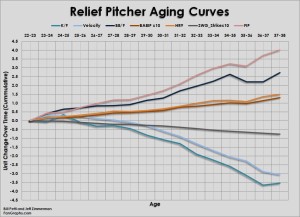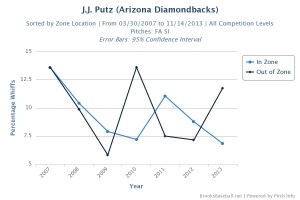J.J. Putz and Declining Fastball Velocity
So far, the Diamondbacks have only brought J.J. Putz into games they have been losing. This seems strange for a man with 189 saves, but the problem is that, in his age-37 season, his velocity has declined. The worries started last April, when he blew four saves. Then he got hurt and missed almost two months. When Putz returned from his injury, he blew a save and did not close for the rest of the year. (He did record a save in a 16-inning affair in August.) The point is that the Diamondbacks started using him in less critical situations.
The team expressed their lack of confidence in Putz by trading for Addison Reed in the winter. On top of that, word was that scouts did not like what they saw from Putz this spring. One big concern was his declining fastball velocity. I wanted to see how quickly his velocity his fastball was declining, and if it should be a concern.
Well, here’s a table on the average velocity of his four-seam fastball from 2007-2013:
| Year |
2007 |
2008 |
2009 |
2010 |
2011 |
2012 |
2013 |
| FB Velocity |
96.74 |
95.01 |
94.12 |
94.19 |
93.73 |
93.50 |
92.21 |
Putz lost an average of 0.607 MPH on his fastball every year. Assuming linear depreciation, we’d expect his fastball to be around 91.6 MPH in 2014.
Unfortunately, it’s not that easy. For one, pitchers don’t seem to lose velocity at a constant rate as they age. Here’s a graph from Jeff Zimmerman and Bill Petti charting velocity change for pitchers based on their age. There’s a lot of information on the graph, but the velocity line is in light blue:
(Click to enlarge)
J.J. Putz is 37. See the data point for pitchers entering their age-37 season? That doesn’t inspire confidence.
In case that graph wasn’t convincing enough, I have two more piece of evidence that suggest Putz will throw slower this year. For one, 91% of pitchers that finish a season down at least 1 MPH from the previous season will lose additional velocity the following season, according to Bill Petti . And second, is that Putz’s velocity has been down this April compared to previous Aprils. Last April he averaged 92.62 MPH and this April it’s been 91.94 MPH. I know, it’s a miniscule sample, but velocity seems more resistant to small sample size bias. It’s much harder to get unlucky with a small sample size when it comes to velocity.
As a result of this, Putz will likely be a worse pitcher, but still good. Putz has only made three appearances this year, so it is too early to draw any conclusions from his performance. But he has been losing velocity over the years, so we can see how he’s dealt with that to draw conclusions about 2014.
Except for one aberration in 2009 with the Mets, Putz posted his worst FIP in 2013 since 2005. His career FIP is 3.20, but it was 3.83. He was striking out batters at nearly the same rate, but that doesn’t tell the whole story. For one, he walked 12.1% of batters, compared to 5.1% and 5.2% in his previous two years. He was throwing fewer strikes, which led to the walks. That much seems pretty intuitive. The increased walks explain his lower FIP, but it seems so strange that his strikeout numbers are staying the same.
Look at percentage of whiffs on his four-seamer and sinker over the last few seasons. (It may not be very clear, because brooksbaseball.net has used varying shades of black for these two lines, but the line that starts at 15% in 2007 is charting the four-seamer.)
It seems like something is wrong here — he’s throwing slower and getting more people to swing and miss. But this next chart, showing the percentage of whiffs on the same two pitches, separated as balls and strikes, explains the uptick.
As you’d expect, the diminishing velocity is leading to less success in the strike zone. But the uptick here in whiffs on his fastball out of the zone combined with more pitches out of the zone kept his strikeout rate constant. Instead of seeing the decline in strikeout rate, we saw Putz throw fewer strikes, which led to an increase in his walk rate.
With David Hernandez out, the Diamondbacks need someone else to pitch in high-leverage situations. Kevin Towers said that Putz is the leading candidate to take his role, per Nick Piecoro. Given the increased walk rates and the diminishing levels of success, I’m not so sure that’s a good idea.
8 Responses to J.J. Putz and Declining Fastball Velocity
Leave a Reply Cancel reply
Recent Posts
@ryanpmorrison
 Congrats to @OutfieldGrass24 on a beautiful life, wedding and wife. He deserves all of it (they both do). And I cou… https://t.co/JzJtQ7TgdJ, Jul 23
Congrats to @OutfieldGrass24 on a beautiful life, wedding and wife. He deserves all of it (they both do). And I cou… https://t.co/JzJtQ7TgdJ, Jul 23 Best part of Peralta’s 108 mph fliner over the fence, IMHO: that he got that much leverage despite scooping it out… https://t.co/ivBrl76adF, Apr 08
Best part of Peralta’s 108 mph fliner over the fence, IMHO: that he got that much leverage despite scooping it out… https://t.co/ivBrl76adF, Apr 08 RT @OutfieldGrass24: If you're bored of watching Patrick Corbin get dudes out, you can check out my latest for @TheAthleticAZ. https://t.co/k1DymgY7zO, Apr 04
RT @OutfieldGrass24: If you're bored of watching Patrick Corbin get dudes out, you can check out my latest for @TheAthleticAZ. https://t.co/k1DymgY7zO, Apr 04 Of course, they may have overtaken the league lead for outs on the bases just now, also...
But in 2017, Arizona ha… https://t.co/38MBrr2D4b, Apr 04
Of course, they may have overtaken the league lead for outs on the bases just now, also...
But in 2017, Arizona ha… https://t.co/38MBrr2D4b, Apr 04 Prior to the games today, there had only been 5 steals of 3rd this season (and no CS) in the National League. The… https://t.co/gVVL84vPQ5, Apr 04
Prior to the games today, there had only been 5 steals of 3rd this season (and no CS) in the National League. The… https://t.co/gVVL84vPQ5, Apr 04
Powered by: Web Designers@outfieldgrass24
 Aw man RIP Roland Hemond, Dec 14
Aw man RIP Roland Hemond, Dec 14 RT @corbin_carroll: Lots of steps to keep climbing but this is a big one. Feels great to be back swinging! https://t.co/VfQ8tZ0Vrc, Dec 10
RT @corbin_carroll: Lots of steps to keep climbing but this is a big one. Feels great to be back swinging! https://t.co/VfQ8tZ0Vrc, Dec 10 Paul Edward Goldschmidt I don’t care what anyone says https://t.co/mTmBywqB1w, Dec 10
Paul Edward Goldschmidt I don’t care what anyone says https://t.co/mTmBywqB1w, Dec 10 Omicron aside, this always felt like the big test — could Americans gather for a holiday (Thanksgiving) and avoid a… https://t.co/S0jEW0UDiC, Dec 09
Omicron aside, this always felt like the big test — could Americans gather for a holiday (Thanksgiving) and avoid a… https://t.co/S0jEW0UDiC, Dec 09
Powered by: Web Designers








What do you guys think would be our ideal bullpen situation? Closer by committee, and just go by matchups in the 7th and 8th?
I like having Ziegler to come in when there’s a jam. Thatcher can take a tough lefty. Harris is capable against lefties, too. Perez is ideal to grab an out or two but not in the highest leverage. Putz and Reed should be able to get high-leverage outs. If you can’t tell, I don’t believe in roles, so I’d suggest mixing and matching to maximize the advantage. I’d keep Perez/Harris/Thatcher/Ziegler for the 5th-8th and have Putz and Reed available in the 8th-9th if I had to form a “traditional” bullpen.
Why are managers so resistant to playing the matchups? Isn’t it better for the team anyways, in terms of potential arbitration for closers?
I agree with Jeff for the most part. In my mind two things are prominent factors in managers’ reluctance to play matchups more. One, it’s the standard way teams operate now. I think there’s a general reluctance to change — baseball people tend to be old-fashioned. Two, and this is the more powerful point, I think player’s benefit from having defined roles. Baseball players generally like to prepare to play a certain way, so if they have a general idea of when they’re going to play, they can time their preparation accordingly. People are also generally more comfortable in roles they’ve been in before.
Although playing matchups seems so intuitive to us, I would note that many of the analytic teams don’t take this approach. I trust that they’ve done their homework, and I think my second point is a factor in them not playing matchups more often.
[…] to see if there were any striking indicators in this category. As Rod pointed out on Tuesday, there are some troubling signs with JJ Putz, but take a look at what I found across the […]
And I was just woderning about that too!
Deadly accurate answer. You’ve hit the bullseye!
Shiver me timbers, them’s some great information.